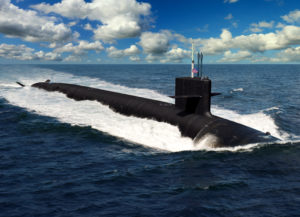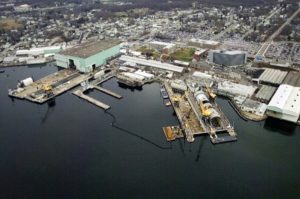The Navy officer in charge of strategic submarines this week said having the right workforce is the biggest challenge to keeping the new Columbia-class ballistic missile submarines (SSBNs) on schedule.
“Principally I’d say my biggest concern is about workforce, and getting the right workforce to go do that, in the skilled trades, both at our nuclear shipyards and throughout the vendor base that provides material that feeds those shipyards,” Rear Adm. Scott Pappano, Program Executive Officer for Strategic Submarines, said in an Air Force Association Mitchell Institute event on Wednesday.

He underscored the domestic U.S. manufacturing base is significantly lower than in the 1980s Navy buildup, but “we need skilled trades feeding our industrial base right now. And so that’s a very big push for us right now.”
Pappano said it has been a challenge getting the workforce for the shipyards and lower tier supply base right. General Dynamics’ Electric Boat [GD] and HII’s Newport News Shipbuilding [HII] build the Navy’s nuclear power submarines, including the SSBNs.
He noted there is a big rampup in submarine construction with the industrial base so that by fiscal year 2026 there will have been about a five-fold rampup over five years from on average building one Virginia-class attack submarine per year to two per year while also adding the Virginia Payload Module to new vessels and now starting work on the Columbia-class as well.
Construction on the 12-ship Columbia-class is split between GD’s facilities in Connecticut and HII’s facilities in Virginia, with GD Electric Boat performing final assembly. They are meant to replace the current 14 Ohio-class SSBNs that entered the fleet in the 1980s.
Pappano reiterated that given the Columbia program is the Navy’s top priority. While the plan is for an 84-month contract delivery schedule per vessel, the Navy is working with shipbuilders to drive that down to 78 months for an earlier delivery.
However, he admitted, “we are behind that 78-month schedule right now, trying to drive back on a restoration path. Still have the 84 months, but there’s risk in that obviously, and so that my goal is obviously to actually drive that schedule back to that 78 months while minimizing the effect on the Virginia-class construction or any carrier construction down at Newport News because, frankly, we need all our forces.”
Pappano said for many years the Navy did not focus on industrial capacity as a national security issue, leaving it up to prime contractors to get what they need in the supply chain.
He said they no longer have that luxury to be transactional and still get what they need from material and the right workforce.
“So although we weren’t very much involved in that in the past, we are driving that very, very hard right now – to develop regional training pipelines in our core concentration areas, driving some accelerated training in defense manufacturing.”

The Navy and industry are starting to work local schools to develop curriculums to incentivize entering that workforce.
Pappano said the trades working “is our key limiter right now…we need a lot more welders and machinists and pipefitters and ship fitters and electricians and I’m working to get the message out right now that you could have a great career in the skilled trades.”
He added that other risks to delivering the Columbia-class on time is that the Navy and industry have not done a full strategic weapons missile test program on a new ship class in over 20 years. Pappano said they are getting the team ready for that and have two more years to work on it.
Pappano noted the Navy also has to make sure the strategic shore infrastructure is ready for the new SSBN class.
“It’s less about delivering the Columbia and more about making sure I have my refit facilities and training facilities ready to go to receive that ship. And in the short term they will be, but making sure I have the right investment in the strategic shore infrastructure to support that ship as soon as it gets there and that capability then supports the Columbia-class into the 2080s as we need it to do.”